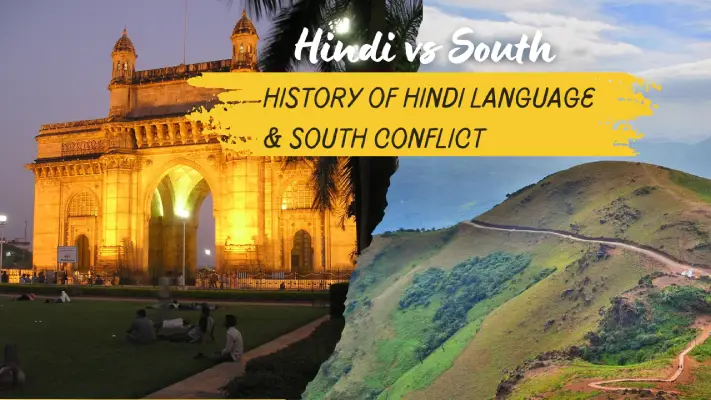Introduction
India’s linguistic diversity is huge, with over 1,600 languages spoken here. Hindi, the most widely spoken language, has been a topic of conflict, especially in South India. The opposition to Hindi in Tamil Nadu has shaped language policies and influenced political and cultural discussions. This article explores the history of the Hindi language, the origins of the South Indian struggle, and the current state of this ongoing debate.
The Evolution of Hindi Language
Sanskrit and Prakrit are the languages from which Hindi was born, which is an Indo-Aryan language. Around the 7th century BC, Apabhraṃśa gave rise to its early expressions. During the Delhi Sultanate and Mughal period, Persian and Arabic influences shaped Hindustani, which later gave birth to contemporary Hindi and Urdu. The British colonial government promoted Hindi in the Devanagari script during the 19th century, which accelerated the efforts for standardization of the language. After independence in 1947, Hindi became the official language of India.
The Origins of the Hindi-South India Conflict
The linguistic divide in India is primarily between Indo-Aryan languages spoken in North India and Dravidian languages spoken in South India. Tamil, Telugu, Kannada, and Malayalam have ancient literary traditions, predating Hindi’s emergence. The first anti-Hindi movement in the 1930s emerged in Tamil Nadu during British rule, arguing that imposing Hindi would threaten Tamil identity and culture. The post-independence controversy (1950s-1960s) saw the Indian government’s attempt to replace English with Hindi as the official language by 1965, but faced backlash in South India, particularly in Tamil Nadu. The Anti-Hindi Agitation of 1965 led to violent protests, student demonstrations, and self-immolations, forcing the government to amend the Official Languages Act in 1967.
How the Conflict Has Evolved
The Hindi-South India divide is influenced by political influence, regional parties, and the rise of regional cinema. Dravidian political parties like the DMK have opposed Hindi imposition and advocated for Tamil identity, making Tamil Nadu the only Indian state where Hindi is not compulsory in schools. The central government has attempted to introduce Hindi in education and administration, but South Indian states, particularly Tamil Nadu, consistently oppose such moves. The National Education Policy (NEP) 2020 faced criticism for promoting Hindi learning, leading to reassurances that no language would be imposed.
Bollywood films dominate, while regional cinema, such as Tamil, Telugu, Malayalam, and Kannada, has gained global prominence. The digital age has also shaped the language debate, with South Indian influencers and content creators highlighting their linguistic pride and hashtagging #StopHindiImposition on social media.
The Current Scenario and Future Prospects
India has a three-language policy, teaching Hindi, English, and a regional language in schools, while Tamil Nadu has a two-language policy due to historical resistance to Hindi imposition. The central government assures no language will be forced upon any state. Despite linguistic differences, South India and Hindi-speaking regions have strong economic and cultural ties. Many South Indians migrate to North India for work, leading to the gradual acceptance of multiple languages in daily life. Hindi-speaking individuals in Tamil Nadu often learn local languages for better integration.
Advancements in technology and AI are making language barriers less significant, allowing seamless communication between Hindi and South Indian languages.
Conclusion
The history of Hindi and its conflict with South India reflects India’s linguistic diversity and regional identity. Hindi has become India’s most widely spoken language, while Tamil and other South Indian languages retain cultural and literary significance. Resistance against Hindi imposition has shaped India’s language policies, ensuring a more inclusive approach. Mutual respect for linguistic diversity is crucial for maintaining unity and preserving India’s rich heritage.

















